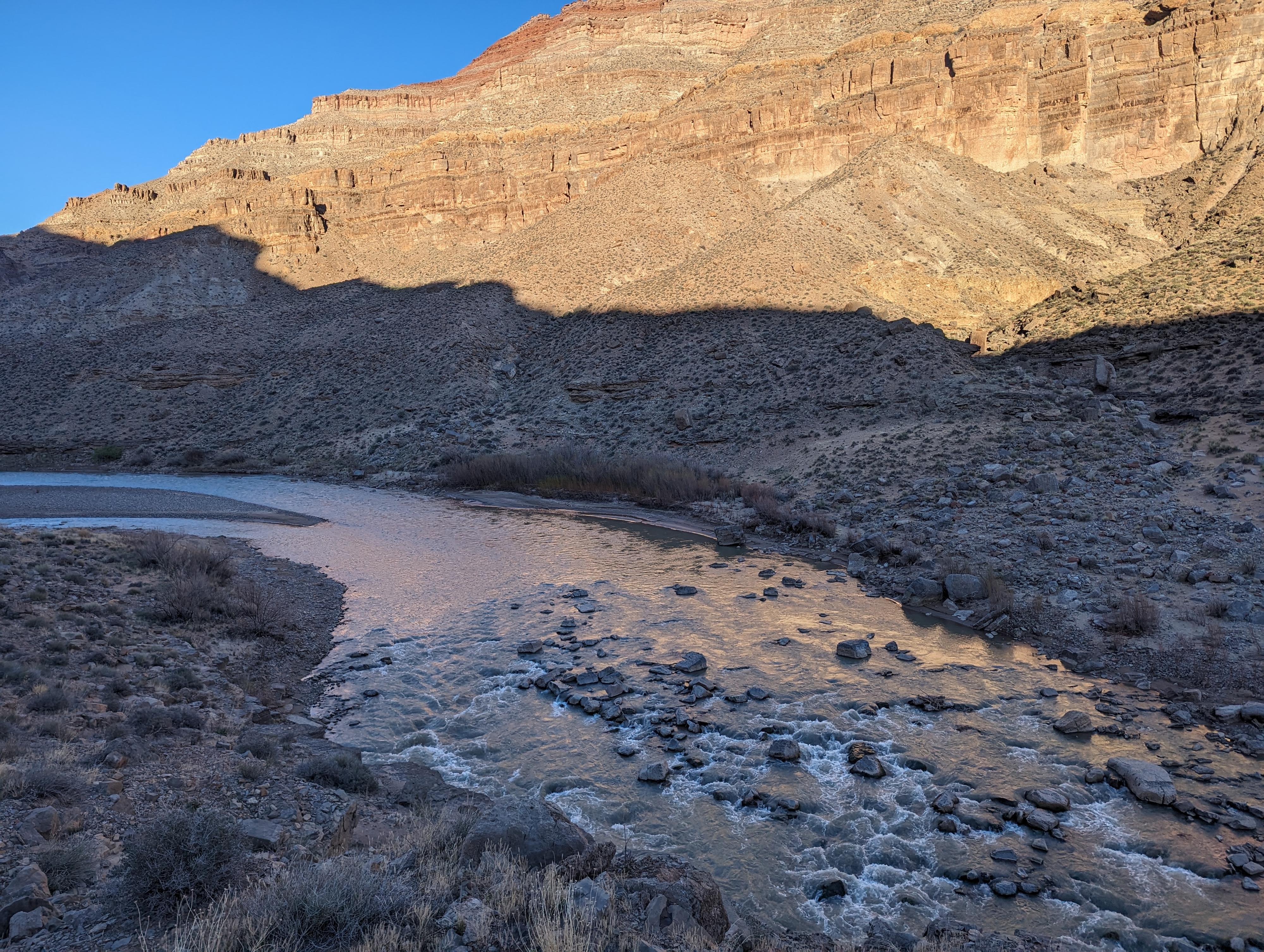 Floating Sand Island to Mexican Hat
Floating Sand Island to Mexican Hat
San Juan River
Overview
|
Mon 52 | 36 |
Tue 50 | 30 |
Wed 50 | 28 |
Thu 49 | 29 |
Fri 44 | 22 |
| View Full Weather Details | ||||
|
Mon 52 | 36 |
Tue 50 | 30 |
Wed 50 | 28 |
Thu 49 | 29 |
Fri 44 | 22 |
| View Full Weather Details | ||||
San Juan River was one of my most sought after trips that took me a long time to actually do! The section described here, from Sand Island to Mexican Hat, is a 27-mile float through both geological wonder and Native American rock art and ruins that are absolutely stunning to behold. This is one of the finest floats in Utah and very family friendly.
Permit: The trip requires a permit. The permit system is a lottery that is drawn months in advance. For details on the lottery, or to enter, see the Recreation.gov site. I am never good at planning that far ahead, so have never entered the lottery.
When: This section is generally float-able year round. Spring and fall would be my preferred seasons for more moderate temperatures. Summer will be hot, but you have the river to cool off in.
Bugs can be a problem at the put-in during spring through fall, but typically don't seem to be a problem below the put-in. I would still bring bug spray just in case.
Trip Length: Some people float this section in one day, others take 4+ days. I believe there is a lot to see, so would recommend at least 3 days. We took 4 and didn't get all the side hikes in I had hoped to.
Water: The BLM recommends bringing all the water you will need for the trip. The San Juan is both silty, and possibly contaminated from mining in the area. Be sure, especially in hotter times of the year, to bring plenty. We brought a gallon per person per day, and it was more than enough for a cool spring trip, but in the heat of summer, I probably would have brought more.
Flows: The BLM recommends 500 CFS, though I saw a few reports of people who had floated it as low as 350 CFS. Our trip was between 500 and 600 CFS in a moderately loaded 16' cataraft. I would, personally, likely not want to go below 500 CFS in that size raft. Higher flows will be a faster float, at 500-600CFS, we averaged about 2.5 MPH with little rowing.
Some canoe this section, but if canoeing, remember it is class II. I, with a fair bit of class I and some class II canoe experience, was glad we had not tried to do it in a canoe. This is not a section I would recommend for those without at least a little Class II canoe experience first. Duckies would work great and be a lot of fun.
On the other end of the spectrum, reports as high as 7,000+ CFS seem to indicate it can be fast and pushy in very high water, but still do-able. For beginning rafters, I would probably recommend 2,000 or less CFS.
Shuttle Logistics: The float requires a shuttle from Mexican Hat to Sand Island. The route is paved and about 22 miles, all but a short dirt section to the Mexican Hat Ramp on pavement.
If you want help with the shuttle, Wild Expeditions in Bluff does them, as does Val's in Mexican Hat.
We got a permit for our trip and felt it was very worthwhile. There are many great campsites and side hikes on the Navajo side of the river.
River Miles and Camping: The map shows river miles, with the put-in, Sand Island boat ramp, being mile 0. Keep an eye on the map to make sure you don't miss any of the excellent side hikes, rock art, or ruins.
Camp sites shown on the map are the larger, more common sites. The ones shown on the map should all be able to hold medium groups. You can, however, camp outside these sites, anywhere that strikes your fancy. Smaller groups will have no shortage of small sites they can find that will be delightful.
We camped the first night at Upper River House Ruin, the second night at Midway, and the third at Fossil Stop, which seemed like a good mix of rafting and having time to explore along the way.
Getting There
Put-In
The put-in is at Sand Island Campground and boat ramp. This is about 4 miles west of Bluff on US-191 heading towards Mexican Hat.
Take-out
From Sand Island, continue heading west on US-191. It soon reaches a junction. Stay straight toward Mexican Hat. The road is now US-163. Just as you reach Mexican Hat, the boat ramp is down a dirt road on the left (south) side of the road. This is at mile marker 21.55, and just before the large gas station on the right. Follow the dirt road down to the river.
Route
Rock art and historic sites are fragile, non-renewable cultural resources that, once damaged, can never be replaced. To ensure they are protected, please:
- Avoid Touching the Petroglyphs: Look and observe, BUT DO NOT TOUCH!
- Stay on the Trails: Stay on the most used trails when visiting sites, and don't create new trails or trample vegetation.
- Photography and Sketching is Allowed: Do not introduce any foreign substance to enhance the carved and pecked images for photographic or drawing purposes. Altering, defacing, or damaging the petroglyphs is against the law -- even if the damage is unintentional.
- Pets: Keep pets on a leash and clean up after them.
- Artifacts: If you happen to come across sherds (broken pottery) or lithics (flakes of stone tools), leave them where you see them. Once they are moved or removed, a piece of the past is forever lost.
The description below mentions the sites that, we thought, were particularly noteworthy. Keep an eye on the map, especially the first 6-7 miles, there is a lot there to stop and see.
From the put-in, it is just a few minutes before the river goes under the highway bridge. Just after the bridge, the river comes close to the cliff on river right. There is supposed to be a rock art panel right here, visible from the river, but we didn't see it. Keep an eye out as you go by!
1.7 Mile Camp, on the right, is the first real camp after the put-in. The river goes by a stunning striped wall here on river left.
3 mile - Just after mile 3, the river goes close to a cliff on river right. There are some moki steps here, visible from the river with a close eye. Just down from here is Butler Camp. From Butler Camp there is a mix of social and animal trails that head north to the cliff where a fascinating rock art panel is. The small panel appears to be a hunter and several sandhill cranes. This can be difficult to find, GPS highly recommended, and it usually requires a bit of bushwhacking. I think it is well worth it.
Between mile 4 and 5 Butler Wash comes in on the right. This major drainage has an impressive rock art panel from its mouth that extends east for several hundred feet along the cliff band. There is also a petroglyph and ruin up lower Butler Wash proper. Follow the map and very well-worn social trails to visit.
The river splits just below Butler Wash. Stay in the right channel if it looks deep enough. There is a set of moki steps here that are harder to see from the left channel. Right where the two channels come back together is Kachina Panel stop.
Kachina Panel
The Kachina Panel is often considered one of the largest and most impressive panels in the area. There is a BLM information sign near the river and a social trail that goes up to, and along the cliff base to visit the panel.
From Kachina Panel, in the next 0.7 mile of river, there are two good camp sites called Upper River House Ruin and River House Camp. Both of these have trails that visit River House Ruin to the north of the river. Follow the most used trail from either campsite. River House Ruin is very easy to spot once close. There are additional ruins just a short distance west of the main ruin, so be sure to walk along the base of the cliff a couple of minutes to see them.
The exact purpose of the River House Ruin remains a subject of scholarly debate, but it is thought to have served as a residential complex, possibly housing several families. Its strategic location near the San Juan River suggests that the inhabitants may have relied on agriculture, fishing, and trade for sustenance and livelihood.
Just below River House Camp, keep an eye high on the left for a panel tucked up among the cliffs.
Just a few minutes down from River House Camp, where the right bank becomes rock and dirt, is Barton Trading Post and San Juan Hill. This is another great spot to stop for a short hike. From the river hike up to visit the old trading post site.
The Rincone (Old Trading Post)
The Rincone, aka Barton's Trading Post, is right next the road past San Juan Hill. From the information sign at the site:
Early one morning in June 1887, two Navajos came into the store and began arguing with Barton. In the heated confrontation that followed, one of the Navajo s pulled a gun and accidentally killed his companion and fatally wounded Amasa Barton. Tense hours and days followed the shooting for it was feared that it could lead to a major confrontation. Through the diplomacy of the settlers in Bluff and Navajo leaders, further bloodshed was prevented.
Following the Bartons, cowboys of the Elk Mountain Cattle Company moved in, making this the center of their operation throughout the late 1880s. Today the walls of the milk house and the platform for the water well (east of here) are all that remain of the trading post.
-Hole-in-the-Rock Association."
San Juan Hill
From the trading post, follow the dirt road north, then west to a spur road that goes to the base of Comb Ridge. Follow the spur road to the fence, information sign, and old wagon trail.
The trail, leading up Comb Ridge behind the fence, is not nearly as well-defined as I expected, but with a close eye, can be followed up. There are occasional historic trail markers along the way as well. We followed it up about 0.4 mile, then stepped off the old trail to the west for nice views. En route there is a short side trail and marker and what, I assume, is an original pioneer inscription: We Thank Thee O God.
Below the trading post area, the nature of the float begins to change. Sandstone cliffs begin to diminish as the geology changes. About mile 9, Chinle Creek comes in on river left. If you have a permit, this is a fantastic drainage to hike up. Stopping at the Lower Chinle Camp allows for easy access to Chinle Creek. Lower Chinle Camp is a large, sandy camp with a few cottonwood trees. It would make a great spot for a layover day if you are interested in hiking.
About mile 10, the river begins cutting into the Honaker formation and the canyon deeps dramatically. Be on the lookout for bighorn sheep throughout the next canyon section. They blend in well, but we spotted quite a few on our trip.
Just before mile 12 is the first named rapid of the trip, Four Foot Rapid. This is an easy read-and-run rapid.
About mile 12.75 Perched Meander comes in on river right. This old abandoned meander can be hiked around. About a 3-mile off trail hike.
Just past mile 13 is Midway Camp on river right. A side canyon comes in here that makes a great side hike. The social trail goes up the bottom of the canyon. Just a few minutes up, a large dry fall is encountered. Most turn around here, we did; however, you can continue up via the steep, loose social trail that bypasses the falls on the right. Above are several more similar falls, though with persistence you can reach the very to of the canyon.
Midway Camp, as well as many of the camps in this canyon section, has a lot of fossils in the limestone rock layer if you keep an eye out.
From Midway Camp, it is about 4 miles to mile 17. Just after mile 17 is Eight Foot Rapid, the most difficult on this stretch. The rapid can be scouted from river left. In general, stay on the right as you go around the bend to go between a large boulder and the right side of the river bank, then pull left back into the center of the channel. Fun little rapid and was bumpy for us in the 500-CFS range.
Below Eight Food Rapid is the narrowest section of the canyon. It is less than 2 miles to Soda Basin, a wider section of the canyon that had oil and gas exploration done in the early 1900's on river right. Some old artifacts are still visible here and worth the stop. An old road links Soda Basin to Lime Creek and makes a great evening hike if camping along this section on river right. I stays close to the river but high enough to get excellent views.
The last named rapid of this stretch, Ledge Rapid, is on the bend at the end of Soda Basin. This is about mile 19.5. The rapid is generally read-and-run. You have to stay relatively right to avoid the shallow, rocky shoal on the left, but pull back from the right enough to avoid being pushed under the overhang on river right. At least at our flows, this was very straightforward.
After Ledge Rapid, it is easy going. The canyon opens broadly at Fossil Stop Camp, about mile 20 and the scenery changes. At about mile 22, as the river makes a bend, there are several sulfur springs up on river right. We stopped to check them out, but most might not find them very interesting. From there, it is about 5 miles to the Mexican Hat Boat Ramp on river right. Be sure not to miss it!
| Sand Island Put-in |
12S 623023E 4124785N 37°15'41"N 109°36'45"W |
| 1.7 Mile Camp (R) |
12S 622362E 4122544N 37°14'29"N 109°37'14"W |
| Goldmine Camp (R) |
12S 622068E 4122657N 37°14'33"N 109°37'25"W |
| 2.2 Mile Camp (R) |
12S 621746E 4122765N 37°14'37"N 109°37'38"W |
| 3 Mile Camp (L) |
12S 620095E 4122390N 37°14'25"N 109°38'46"W |
| Moki Steps |
12S 619792E 4122527N 37°14'30"N 109°38'58"W |
| Butler Wash Camp (R) |
12S 619545E 4122171N 37°14'18"N 109°39'08"W |
| Crane Hunter |
12S 619381E 4122388N 37°14'25"N 109°39'15"W |
| Ruin |
12S 618424E 4122279N 37°14'22"N 109°39'53"W |
| Petroglyph |
12S 618362E 4122071N 37°14'16"N 109°39'56"W |
| Panels |
12S 618505E 4121987N 37°14'13"N 109°39'50"W |
| Moki Step View |
12S 618229E 4121761N 37°14'06"N 109°40'02"W |
| Kachina Panel Stop (R) |
12S 618040E 4121583N 37°13'60"N 109°40'09"W |
| Desecration Camp (L) |
12S 617866E 4121023N 37°13'42"N 109°40'17"W |
| 5.7 Upper River House Camp (R) |
12S 617217E 4120407N 37°13'22"N 109°40'44"W |
| River House Camp (R) |
12S 616289E 4120007N 37°13'10"N 109°41'21"W |
| Petroglyph High River Left |
12S 616264E 4119906N 37°13'06"N 109°41'22"W |
| River House Ruin |
12S 616390E 4120420N 37°13'23"N 109°41'17"W |
| Panel |
12S 616514E 4120466N 37°13'24"N 109°41'12"W |
| Joe's Corral |
12S 617213E 4120869N 37°13'37"N 109°40'43"W |
| Cottonwood Camp (L) |
12S 616034E 4119877N 37°13'05"N 109°41'32"W |
| Old Trading Post |
12S 615799E 4120033N 37°13'11"N 109°41'41"W |
| San Juan Hill Sign |
12S 615557E 4120296N 37°13'19"N 109°41'51"W |
| Pioneer Inscription |
12S 615567E 4120748N 37°13'34"N 109°41'50"W |
| Comb Ridge Camp (R) |
12S 615446E 4119916N 37°13'07"N 109°41'56"W |
| Lime Ridge Camp (R) |
12S 614058E 4119143N 37°12'43"N 109°42'52"W |
| Upper Chinle Camp (L) |
12S 614164E 4118689N 37°12'28"N 109°42'48"W |
| Chinle Camp (L) |
12S 614128E 4118378N 37°12'18"N 109°42'50"W |
| Big Stick Camp (R) |
12S 613869E 4118070N 37°12'08"N 109°43'01"W |
| Chinle Creek |
12S 614118E 4117778N 37°11'58"N 109°42'51"W |
| Lower Chinle Camp (L) |
12S 613475E 4117410N 37°11'47"N 109°43'17"W |
| Mule Ear Camp (L) |
12S 613317E 4117030N 37°11'34"N 109°43'24"W |
| 10.3 Camp (Small) (R) |
12S 612436E 4117423N 37°11'47"N 109°43'59"W |
| 10.4 Camp (L) |
12S 612369E 4117628N 37°11'54"N 109°44'02"W |
| Prospector Loop Camp (R) |
12S 611632E 4117698N 37°11'57"N 109°44'32"W |
| Perched Meander |
12S 611211E 4119565N 37°12'57"N 109°44'48"W |
| Midway Camp (R) |
12S 610767E 4118958N 37°12'38"N 109°45'06"W |
| 14.9 Camp (L) |
12S 609203E 4117044N 37°11'37"N 109°46'10"W |
| 15.5 Camp (R) |
12S 609524E 4116353N 37°11'14"N 109°45'58"W |
| Eight Foot Rapid |
12S 607848E 4115970N 37°11'02"N 109°47'06"W |
| Lower Eight Foot Camp (L) |
12S 607818E 4116258N 37°11'12"N 109°47'07"W |
| Below Lower Eight Foot Camp (L) |
12S 607762E 4116419N 37°11'17"N 109°47'09"W |
| Old Well |
12S 605670E 4116385N 37°11'17"N 109°48'34"W |
| Old Structure |
12S 605603E 4116383N 37°11'17"N 109°48'37"W |
| Rock Chimney and Foundation |
12S 605660E 4116485N 37°11'20"N 109°48'34"W |
| Ledge Rapid |
12S 605437E 4115838N 37°10'59"N 109°48'44"W |
| Ledge Camp (L) |
12S 605386E 4115761N 37°10'56"N 109°48'46"W |
| Lower Ledge Camp (L) |
12S 605257E 4115535N 37°10'49"N 109°48'51"W |
| Fossil Stop Camp (R) |
12S 604121E 4115526N 37°10'49"N 109°49'37"W |
| Stairmaster Camp (L) |
12S 603824E 4115447N 37°10'47"N 109°49'49"W |
| Lime Creek Camp (R) |
12S 603075E 4115888N 37°11'02"N 109°50'20"W |
| Sulfur Springs |
12S 602182E 4117162N 37°11'43"N 109°50'55"W |
| Pouroff Camp (R) |
12S 601773E 4116944N 37°11'36"N 109°51'12"W |
| Mexican Hat Camp (L) |
12S 601905E 4115677N 37°10'55"N 109°51'07"W |
| 25 Mile Camp (L) |
12S 603787E 4113705N 37°09'50"N 109°49'52"W |
| Mexican Hat Takeout |
12S 601798E 4111808N 37°08'50"N 109°51'13"W |



















